Liz Alpert Fay interview: Hand hooked art
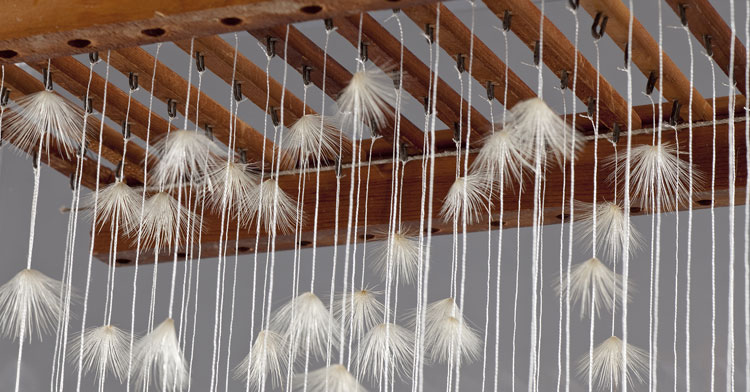
Liz Alpert Fay is a New England native and an outdoor enthusiast. She largely credits her family, especially her grandfather, for providing her with the creative inspiration to master hooking, quilting, spool knitting, punch needle embroidery, and several other techniques.
Driven by the sheer curiosity to learn how things are made, Liz has developed a passion for exploration. While the urge to innovate is at the forefront of her work, her famous hand hooked rugs are made in a very traditional manner.
Liz Alpert Fay received a BAA in Textile Design from The Program in Artisanry at Boston University, and her work has been featured in many books, such as Fiberarts Book 7. She is also responsible for the publication of Hooked Art 2014, an exhibition of contemporary hooked art.
In this interview, we got to catch a glimpse at the assortment of techniques Liz uses in crafting her hand hooked art and mixed media sculptures, and the influence her grandfather had in her creative development. We also learn about the potential for her future work that may include installation or performance art.
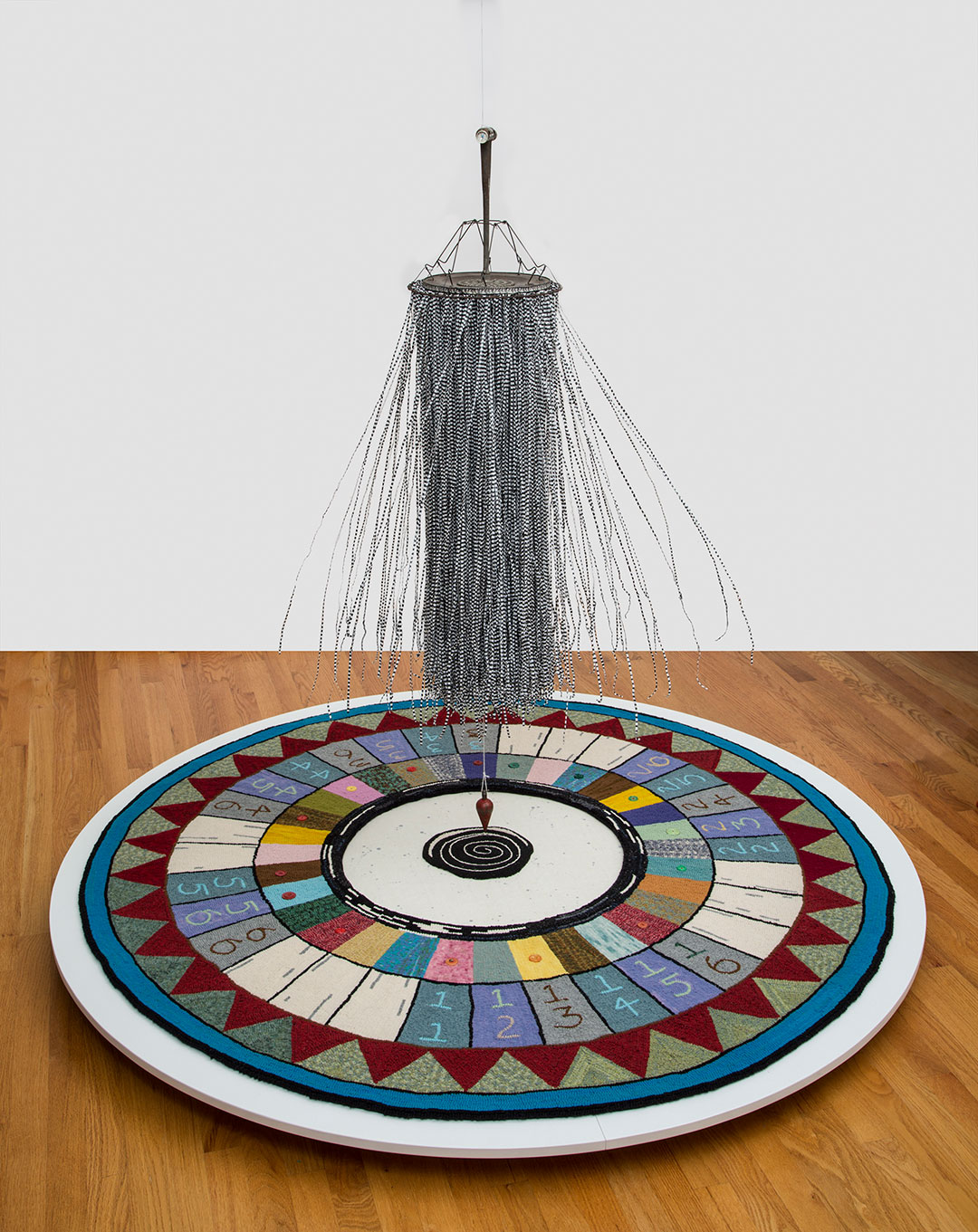
“True North”, 60” x 60” diameter, 2014
Sculpture: Plastic, reclaimed metal, compasses, string, plumb bob.
Center: Punch needle embroidery, cotton.
Rug: Wool hooked on linen, vintage buttons.
Paddles: Cashmere hooked on linen, wood, waxed linen twined, ribbon.
How things are made
TextileArtist.org: What was your route to becoming an artist?
Liz Alpert Fay: As a child I was always curious about how things were made. I taught myself how to create these things by following the directions in books. I learned to quilt, weave, and to spin and dye wool. By the time I reached my senior year in high school, I was ready to take on more challenging projects, and was excited by the prospect of attending art school.
I enrolled at the Philadelphia College of Art (now University of the Arts) where I spent two years. The first year was one of the best in my college experience. They had a fabulous (and rigorous) foundation program where we were taught many skills, many of which I still use today.
The next year I was able to declare myself a textile major, but didn’t feel the program was a good fit. I transferred to the Program in Artisanry at Boston University where I double majored in Weaving and Surface Design, graduating with a Bachelor of Applied Arts in Textile Design.
Today I am still curious about how things are made. I’m still learning from reading books, but have also found YouTube videos to be a good resource from time-to-time.
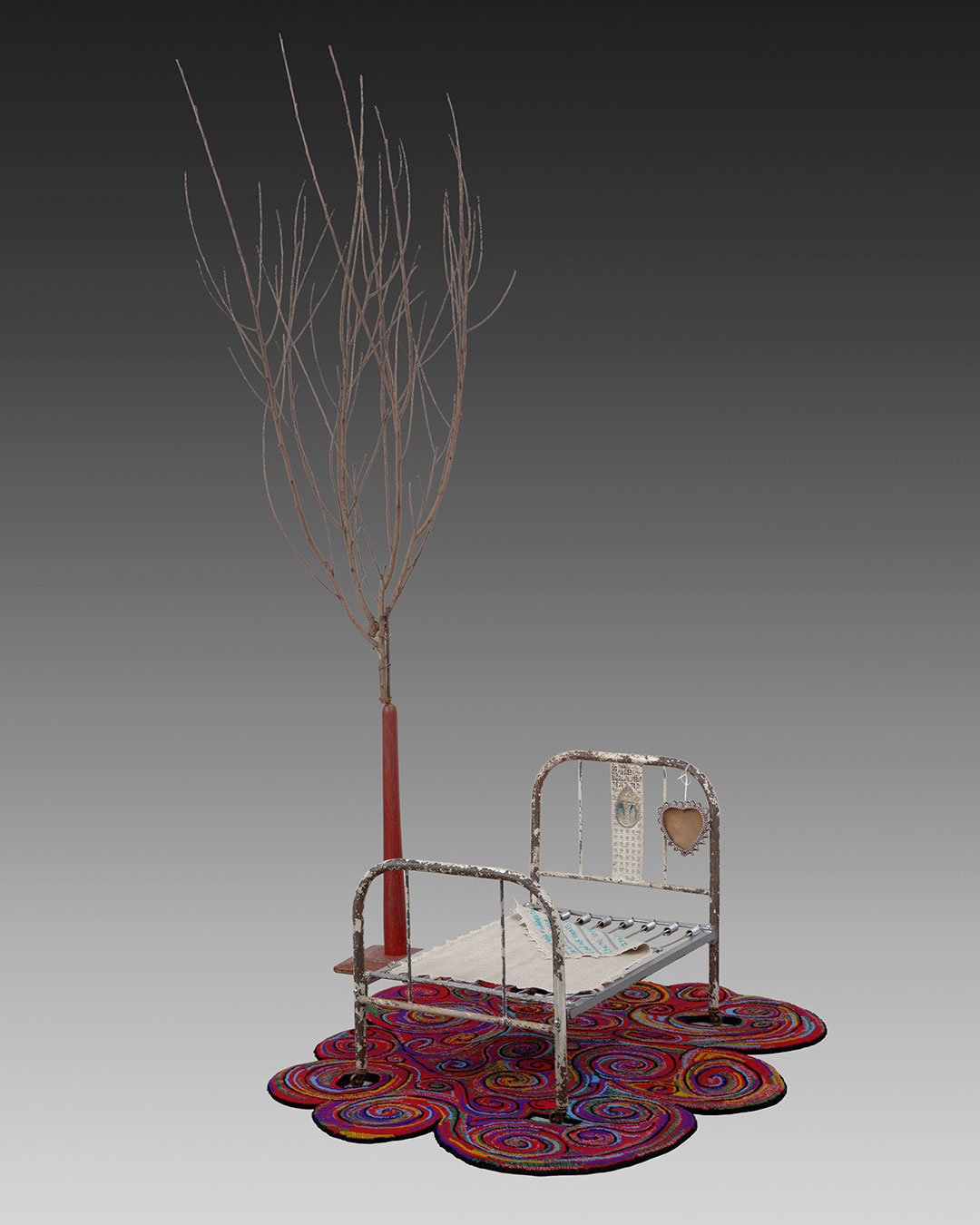
“Collector of Words, I Dream in Color”, 85” X 40” 45.5”, 2011
Reclaimed metal bed, beaded picture frame, wooden base, old map, tree branch.
Rug: wool hooked on linen.
Antique linen, vintage trim, hand embroidered.
Unusually shaped objects
What is your chosen medium and what are your techniques?
I describe myself as an artist who makes hand hooked art and mixed media sculptures.
The hand hooked art is usually created with wool that I recycle from discarded clothing and from new white wool that I hand dye. On occasion, I will hook with materials not usually associated with rug hooking, such as paper, plastic or shoelaces. The material is cut into strips and hooked into a backing of linen. I prefer using the traditional rug hooking technique, but will use punch hooking or punch needle embroidery when appropriate. I am passionate about pushing the boundaries of this medium in new directions, and interested in how we interact with these objects in our surroundings and in our every day lives.
By creating unusually shaped objects, cutting and binding holes, exploring unusual color combinations and textures, and combining techniques, I am trying to change the perception of what is commonly thought of as “traditional rug hooking.”
The mixed media sculpture I have been creating usually combines my textile work with found objects. Here I am employing whatever textile technique works best to convey my ideas. These objects are collected at local flea markets or gathered from nature. Some of the techniques I have used in these pieces are:
- hooking
- quilting
- spool knitting
- needle felting
- various stitching techniques
- punch needle embroidery
My inspiration in creating these pieces is drawn both from the beauty of these collected objects as well as the desire to rescue, preserve and give them a new life.
Most recently, I have been creating sculptures purely out of the natural materials I have gathered. I find these materials to be so beautiful that they need little enhancing. The challenge is to preserve and manipulate them to their best advantage. Most of these constructions are very fragile and are housed in UV acrylic boxes.
How would you describe your work and where do you think it fits within the sphere of contemporary art?
I feel that I have one foot in the fiber world and one in the art world. Sometimes these places are one and the same, but often they are not.
Most of my work is on a large scale and I am becoming more and more interested in creating installations and possibly even performance art. I’m interested in the connections we make with our environments and how we feel in these places.
Do you use a sketchbook?
I use a sketchbook just to jot down ideas – both visual and written. I feel cramped drawing on such a small scale, and prefer to draw my ideas full size. I tend to work large, and like to put my whole body into the process. For example, I like to use my whole arm to draw a curve or a swirl. I like the full action of the movement.
We have a local newspaper in town that gives away free newsprint. Having this supply of large rolls of paper to draw on is very freeing.
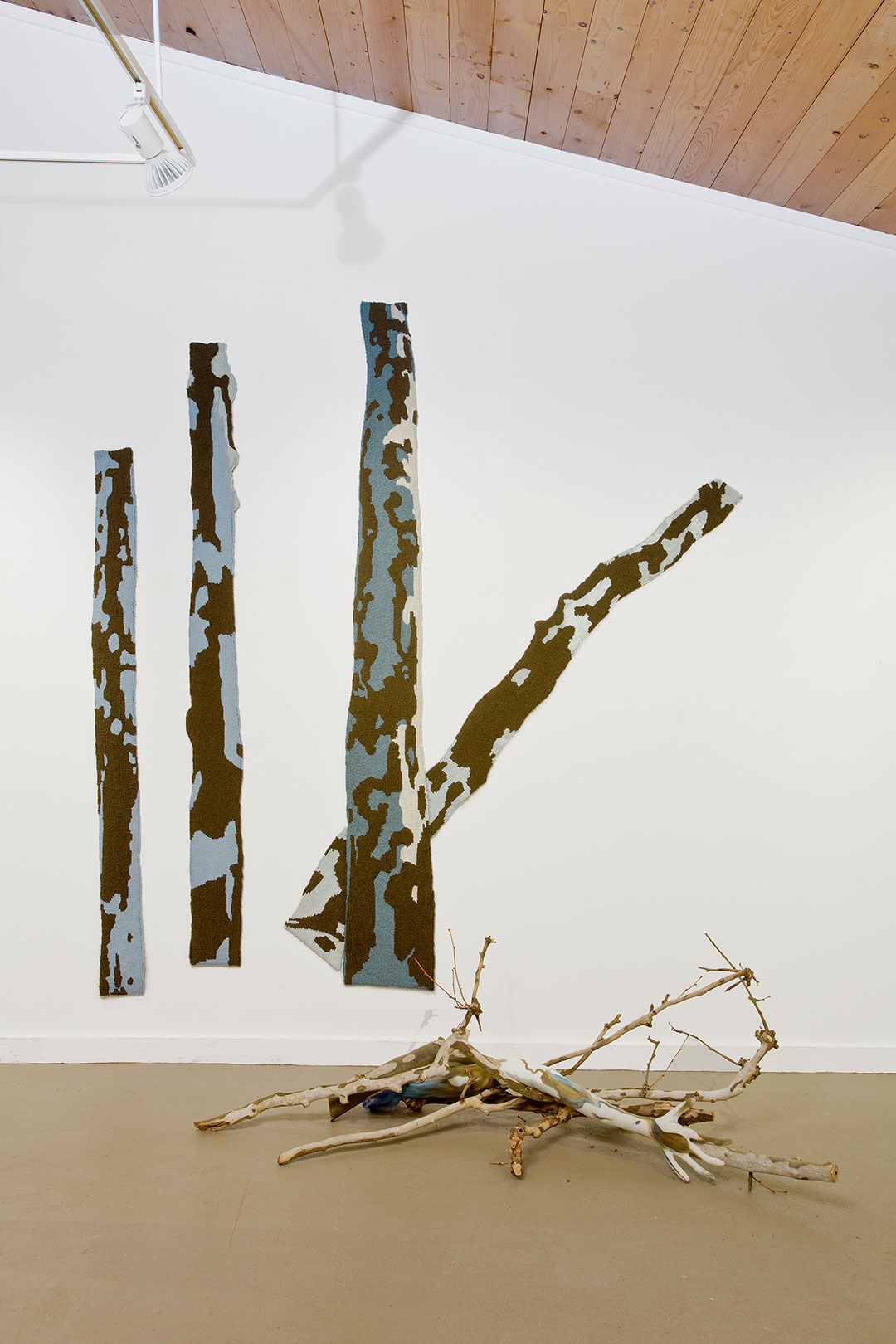
“Sycamore Trees: The Human Connection”, 102” x 102” x 36” (Installation
size), 2012
Trees: Wool hooked on linen.
Needle felted arm: wool, batting, Sycamore branches.
A constant source of wonder
What currently inspires you and which other artists do you admire and why?
The vegetable garden in my backyard has been cultivated organically for over 50 years. I have inherited this plot and feel honored to continue working the soil. Over the past few years I have crowded the vegetables a bit, by turning this plot into an experimental lab of sorts. I have been cultivating plants from seeds that I have gathered in the wild, and it has become a constant source of wonder. The various stages of these plants and their ability to reproduce fascinate me. I am particularly interested in the seeds and their methods of transporting themselves, and have created several pieces incorporating them into my artwork.
I am also drawn to the forests and deep woods of the Adirondack Mountains in upstate New York. For me these woods are spiritual places. I feel very much at home there, and very inspired.
There are many artists whose work I really admire, but a few definitely top the list.
Alexander Calder is my all-time favorite artist. I’ve visited his work in museums and galleries across the country. I think what I admire most about his work is the whimsical quality of most of his pieces. I’m also inspired by the gracefulness of his mobiles and wire sculptures, and the beautiful kinetic shadows that they create.
I also really love the paintings of Emily Carr, Tom Thomson, Harold Weston, and Charles Burchfield. I’m drawn to their free use of color, and the feelings of exuberance they are able to create within their landscapes. I admire their ability to capture that special spiritual quality of a place.
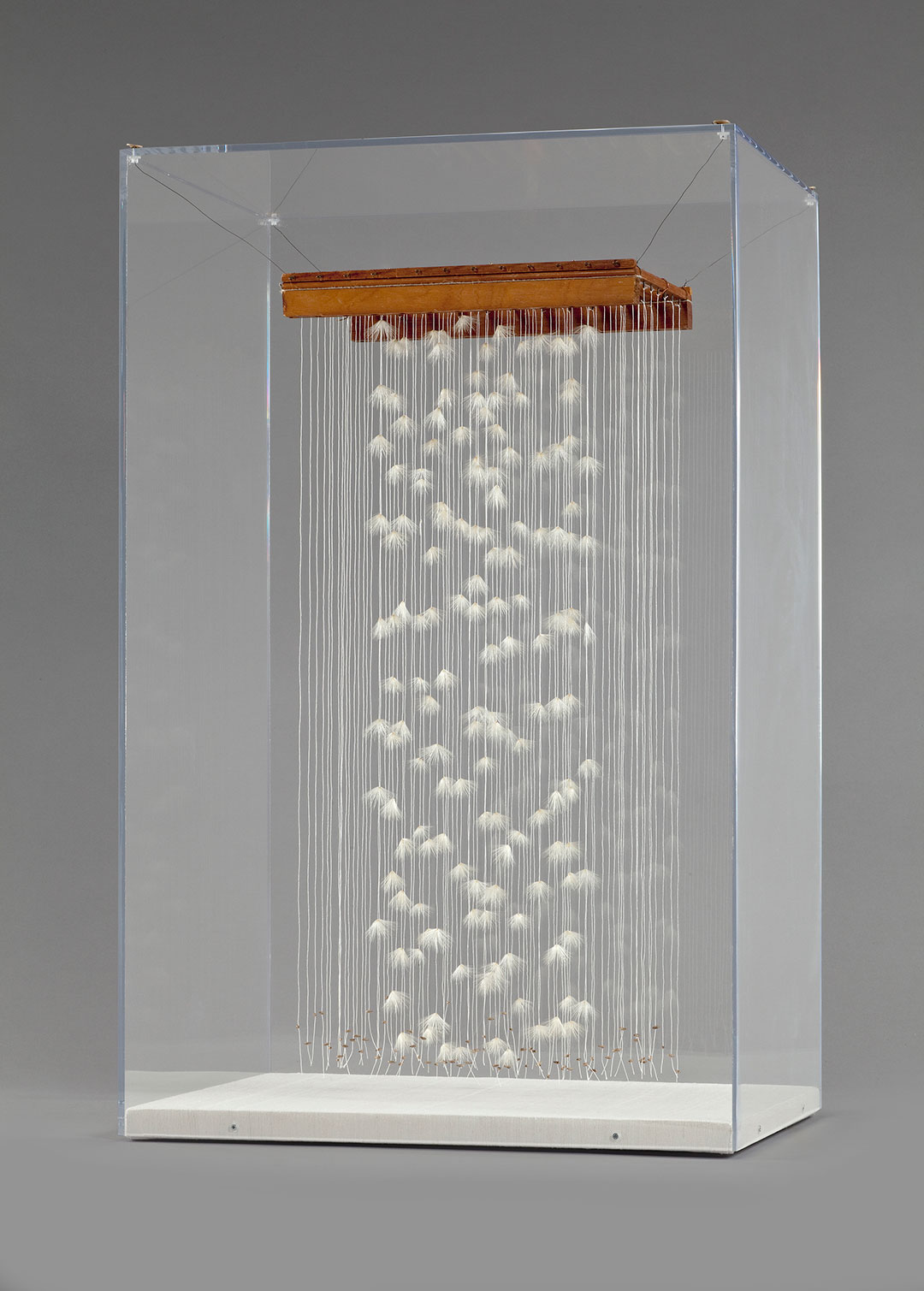
“Milk Thistle”, 33” x 16.5” x 21” (in UV acrylic box), 2009
Reclaimed wood, rayon thread, wire, buttons, Milk Thistle seeds.
In the eyes of an older child
Tell us about a piece of work you have fond memories of and why?
When I was a child, I had a very wonderful grandfather who made up magical stories and taught us to make things with our hands. He fueled our imaginations in many ways. One of the special bonds that he and I shared was a secret code that he taught to me. We would write letters to each other and post them in the mail. No one else new the code, so it made it even more special.
Sadly, when I was in college, my grandfather passed away. I found one of the letters he had written to me, and decided I would write something to honor him using our secret code.
At the time, I was making art quilts and decided to use that medium. The quilt was made with a solid black piece of fabric on top. Underneath I painted a piece of raw silk with lots of bright colors. Using the technique of reverse applique, I cut the symbols of the code through the black fabric, to reveal the colors beneath. In another medium, this could be compared to scratch board, where black crayon is scratched away by children to reveal the colors beneath.
The title of this quilt is “A Letter From Arthur” and it measures 51 x 45 inches.
The last lines of what I wrote about my grandfather were these:
“This quilt …is an attempt to keep the wonderful magical qualities alive… in the eyes of an older child.”
My mother had the quilt hanging in her house for many years. She recently moved to smaller quarters, and the quilt now hangs in my home.
The quilt was exhibited at Quilt National ’85 and The American Folk Art Museum, NYC. It also traveled to Japan. It was published in The New York Times, American Craft magazine and The Art Quilt by Robert Shaw.
All this would make my grandfather very happy!
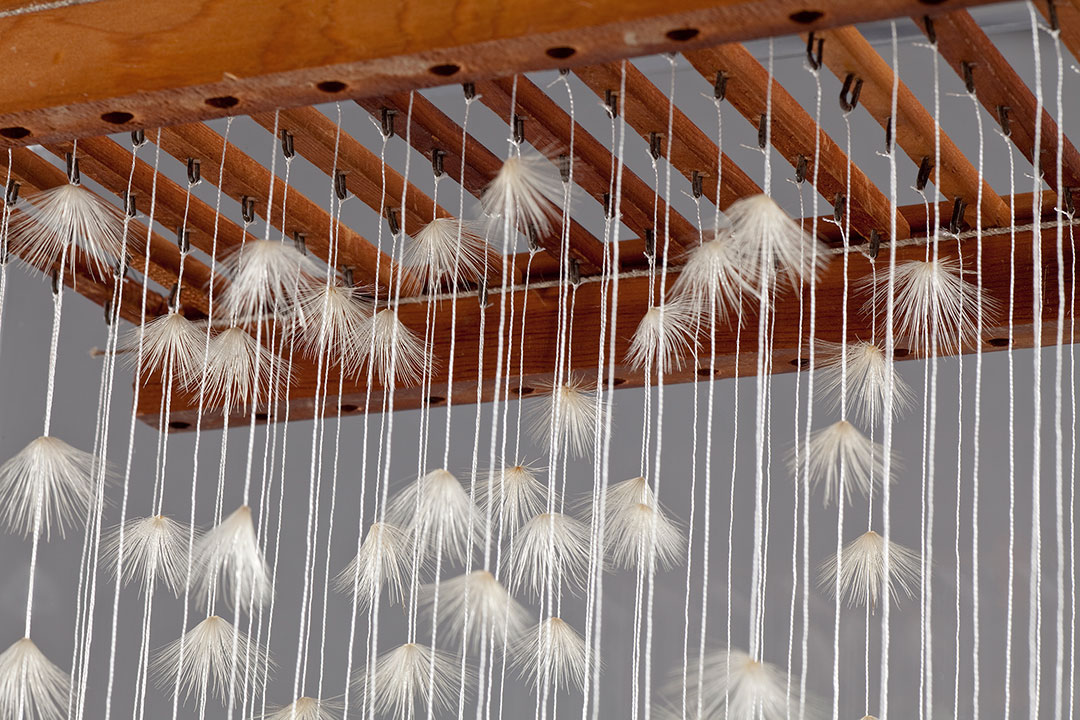
“Milk Thistle” (detail), 33” x 16.5” x 21” (in UV acrylic box), 2009
Reclaimed wood, rayon thread, wire, buttons, Milk Thistle seeds.
A weakness for books
What advice would you give to an aspiring textile artist?
Be true to yourself and work from the heart.
Also, go to grad school! Not going is the only regret I have had in my career.
What other resources do you use?
I try not to spend too much time on the computer. I find it eats up too much of my time. I do subscribe to quite a few magazines, such as:
I try to keep up with the New York Times.
I also have a weakness for books. Especially those large hard cover books with big beautiful color photos!
The very fragile pieces
What piece of equipment or tool could you not live without?
If I could only pick one tool to have, it would probably be scissors. I work with a wide variety of materials and techniques that require their own set of tools, but I think scissors are common to them all. My rug hook, frame and cutter are important to me for hooking. I have a toolbox with hammers and screwdrivers for working on sculpture, and a huge variety of sewing needles and hand tools for other textile techniques.
In my studio, I have a padded table that I use for pinning, blocking and ironing. I also have a very large, beautiful light table, given to me by a neighbor when he moved. It took five strong men to get it into my studio! I use it for transferring my designs from paper to cloth. I also have a design wall where I can pin up my work. I find this invaluable.
I suppose I should include my computer, printer, and scanner here, too. I use them every day, as well as my camera.
Do you give talks or run workshops or classes? If so, where can readers find information about these?
I give talks and workshops occasionally when I am asked. I post these on my website and also advertise them through email and my online newsletter that comes out every other month. You can sign up for the newsletter through my web site.
I don’t plan my whole year ahead, so check my website periodically for updates.
How do you go about choosing where to show your work?
I have a number of criteria for exhibiting my work. First I look at the venue to see if I would want to exhibit there, and if so, would it be a good fit for my work?
Then I look at who is selecting the work.
And finally, how far away is the venue?
Some of my work is easy to ship, but many of my pieces are difficult to transport. So far, the large, heavy pieces have only been exhibited close to home. The very fragile pieces cannot be shipped, so again, they have only been exhibited as far as I have been willing to drive.
I would like these pieces to travel further from home, and I hope some day opportunities will come along to show large bodies of my work in distant places. I think then I will be happy to make the necessary arrangements!
To learn more, please visit: www.lizalpertfay.com
















Absolutely outstanding work! Truly original.
Inspiring! Love the story of Letter from Arthur’s quilt and would love to see picture but understand the personal quality of it and feel inspired to use the idea-for which ‘thank you’!
Thank you so much for sharing this interview. It was wonderful to be able to revisit a number of my favorite works of yours (Milk Thistle being my all time favorite!). It was also fun taking a detour and exploring the history and work of your favorite artists. All very inspiring!